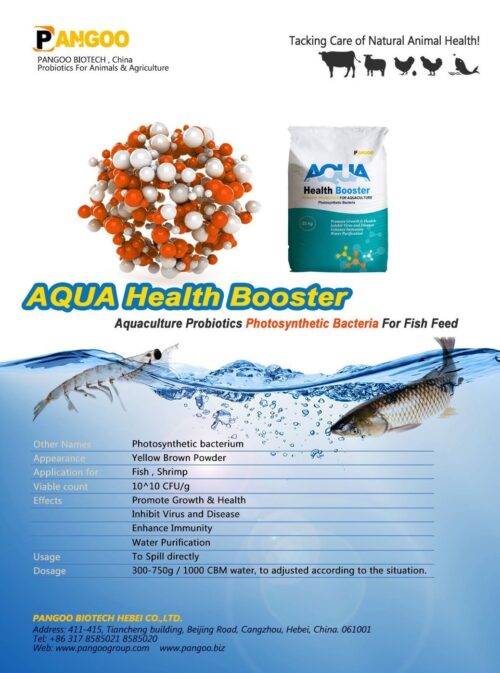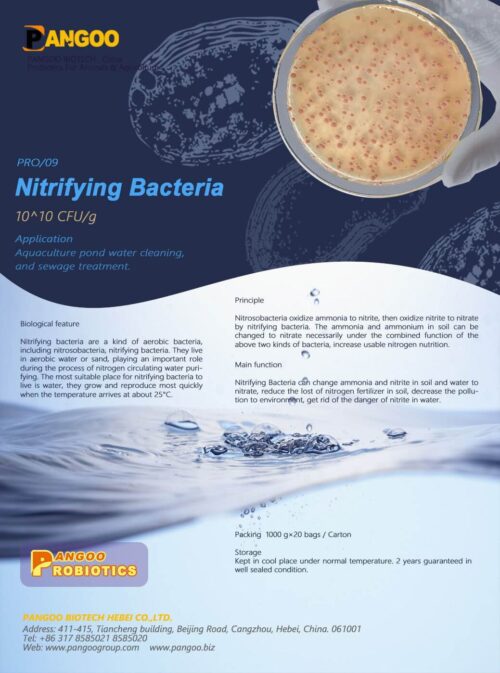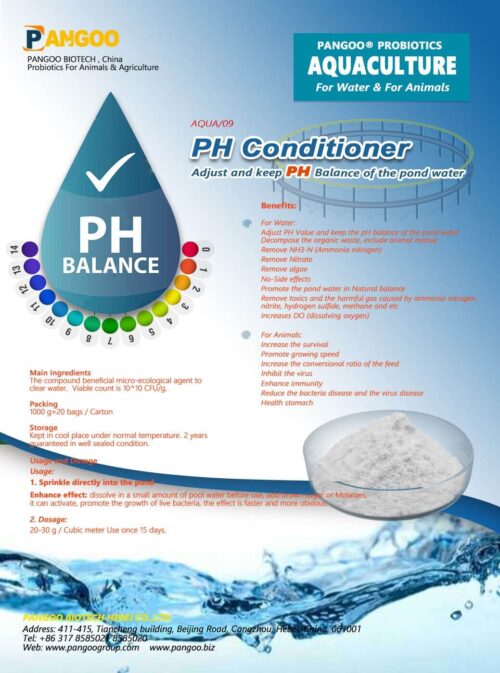In the realm of aquaculture, innovative strategies to enhance the health and productivity of aquatic ecosystems are continually pursued. Probiotics, known for their beneficial impact on the gut flora of terrestrial animals, have found a significant place in aquaculture practices. Harnessing the power of these microbial wonders can revolutionize the industry. With an array of products like BioAqua and Nitrifying Bacteria, among others, the aim is to not only boost the health of aquatic organisms but also the sustainability and productivity of aquaculture operations globally.

| Probiotics in Aquaculture | Description |
|---|---|
| Probiotic Definition | Live microorganisms that confer health benefits |
| Aquaculture Health | Enhances gut flora, boosts immunity, improves water quality |
| Product Offerings | High-quality probiotics products like BioAqua |
| Sustainability Impact | Contributes to environmentally sustainable practices |
This comprehensive discourse delves into the beneficial bacteria that form the cornerstone of probiotic applications in aquaculture, the science behind their effects, and the significant contribution they make to this burgeoning industry.
Aquaculture is an essential component of the global food system, providing nutritional security and livelihoods to millions worldwide. Balancing the increasing demand for seafood with environmental sustainability and fish health is a challenge that probiotics are uniquely equipped to meet. In aquaculture, probiotics can improve water quality, enhance disease resistance, and promote growth in aquatic organisms, making them a pivotal addition to fish farming and other aquacultural practices.
What are probiotics? Simply put, they are live microorganisms that, when administered in adequate amounts, confer a health benefit to the host. In the context of aquaculture, these beneficial bacteria are used to maintain a healthy microbial environment, which is critical for the wellbeing of fish and other aquatic organisms.
The science behind probiotics in aquaculture is rooted in gut health. The gut flora of fish plays a crucial role in their overall health, affecting everything from the immune response to the efficiency of digesting food.
The primary function of probiotics in aquaculture is to stabilize the intestinal microbiota, leading to enhanced growth and health of fish. These supplements can reduce the occurrence of infections and improve the environmental conditions within aquaculture systems by breaking down organic waste and outcompeting pathogenic bacteria.
Case studies have shown that probiotics are not only beneficial for the animals themselves but can also have significant positive impacts on the operational aspects of aquaculture, such as feed conversion ratio optimization and bioaugmentation of water systems.

Different strains of probiotics serve different functions in aquaculture. Some strains, like Lactobacillus, help enhance the immune system of fish, while others, like Bacillus, are essential for nutrient absorption and growth.
BioAqua is a perfect example of the commitment to enhancing aquaculture health. This product encapsulates the benefits of probiotics in a formula designed specifically for aquatic organisms. By bolstering their immune systems and promoting a balanced microbial environment, BioAqua serves as a cornerstone product in the pursuit of a healthier aquaculture ecosystem.
The Aqua Photosynthetic Bacteria (APB) product plays a pivotal role in the improvement of the aquatic environment. These bacteria harness the energy from light to convert inorganic substances into organic substances, providing a rich source of nutrients for aquatic organisms. The APB contributes to water purification, reduction of harmful gases, and enhancement of water quality, making it an invaluable asset in any aquaculture operation.
By implementing APB, aquaculture practitioners can anticipate healthier aquatic organisms and more robust ecosystems. The photosynthetic bacteria present in this product not only improve water conditions but also promote a better growth rate in fish and shrimp, proving the far-reaching impact of these beneficial microorganisms.

Nitrifying bacteria are essential for maintaining nitrogen balance in aquaculture systems. They convert toxic ammonia, produced by fish waste, into less harmful substances such as nitrites and nitrates. The PRO/09 Nitrifying Bacteria product enriches the aquatic ecosystem with these beneficial bacteria, ensuring optimal water conditions for the health and growth of aquatic life.
The incorporation of this product into aquaculture practice leads to enhanced biofiltration capabilities and better regulation of the nitrogen cycle within ponds and tanks. This proactive approach to managing water quality underscores the importance of probiotics in sustainable fish farming.
A key aspect of successful aquaculture lies in the ability to sustain excellent water quality. Probiotics serve as natural bioremediators, enhancing water transparency and reducing the buildup of organic sludge. The balanced microbial ecosystem that probiotics support plays a crucial role in the degradation of waste, thus reducing the likelihood of waterborne diseases among aquatic species.
Furthermore, the utilization of probiotics as part of a comprehensive aquaculture management strategy can lead to reduced need for chemical treatments, emphasizing the importance of incorporating bioaugmentation practices into modern aquaculture operations.

The Biofloc system represents an innovative and eco-friendly approach to aquaculture. It relies on the growth of beneficial microbial communities, or 'bioflocs', to recycle waste nutrients into a valuable natural feed for the aquatic organisms. Probiotics are instrumental in establishing and maintaining these bioflocs, which in turn boost productivity by improving water quality and providing supplementary nutrition for fish and shrimp.
The synergy between probiotics and Biofloc technology results in optimal feed conversion ratios and enhanced overall productivity of aquaculture systems, aligning with principles of sustainability and efficiency sought after in the industry.
The Aqua Health Booster by Pangoogroup is designed to support the overall well-being of aquatic organisms by enhancing their immune response and resistance to disease. This product is a blend of probiotics, vitamins, and minerals formulated to promote vitality and stress resilience in fish and other aquatic species.
Given the numerous challenges faced by aquaculture operations, the Aqua Health Booster emerges as an essential component of preventive health management, potentially reducing reliance on antibiotics and other pharmaceuticals in aquaculture systems.

Probiotics are well-recognized for their role in enhancing the immune systems of aquatic organisms. These beneficial microorganisms contribute to the development of a stronger defense mechanism against pathogens, which is vital for maintaining the health and survival rates of cultured species.
Studies have consistently indicated that probiotic supplementation can lead to increased production of immune-related enzymes and proteins, bolstering the immune response in aquaculture. Therefore, the strategic use of probiotics in fish diets not only contributes to gut health but also fortifies fish against diseases, which, in turn, can significantly reduce mortality rates.
The method of introducing probiotics into aquaculture systems can greatly influence their efficacy. Probiotic application techniques include adding them directly to the water, incorporating them into feed, or through bioencapsulation with live food organisms. Each method has its own advantages, and choosing the right technique is paramount for achieving the best results in aquaculture operations.
It is crucial for practitioners to adhere to best practices when applying probiotics. This includes selecting appropriate strains, dosages, and ensuring regular application to maintain the optimal microbial balance within the aquaculture environment.
Pangoogroup's Aquaculture Yeast product exemplifies the incorporation of probiotics in a form that provides an excellent source of vitamins and amino acids beneficial for aquatic organisms. Yeasts, a type of fungi, can enhance gut health and improve the feed conversion ratio, making them a vital ally in the pursuit of productive aquaculture.
Moreover, yeast probiotics can act as a significant source of immunostimulants and can help maintain the water quality in aquaculture systems. Their usage reflects the dedication of Pangoogroup to deliver advanced and scientifically-backed solutions for enhancing the efficiency and resilience of the aquaculture industry.

The application of probiotics in aquaculture extends beyond nutritional benefits to playing a critical role in pathogen control. By maintaining a balanced and competitive gut microflora, probiotics can prevent the colonization and proliferation of pathogenic bacteria, thereby acting as a natural control mechanism.
This bio-security aspect contributes to the overall health of the aquaculture ecosystem and allows for a reduction in the use of antibiotics and chemical treatments, which aligns with global sustainability goals and consumer demands for naturally-produced seafood products.
An investment in probiotics can be viewed through the lens of an economic trade-off, weighing the costs of probiotic products against the numerous benefits they offer. These benefits range from enhanced growth rates and feeding efficiencies to decreased disease treatment costs and lower fish mortality rates.
Studies and case studies in the industry demonstrate that implementing a probiotic program can lead to tangible economic benefits, such as improved yield, better-quality produce, and enhanced profit margins, which are crucial factors in the success of any aquaculture endeavor.
In the quest for a more sustainable aquaculture industry, probiotics emerge as a beacon of hope. They are integral to the development of environmentally sustainable practices that can cater to the growing demand for seafood while mitigating negative impacts on ecosystems. The reduction of feed waste, improvement of water quality, and minimization of disease outbreaks through natural means aligns perfectly with the goals of sustainable aquaculture. This proactive approach underscores the industry's commitment to promoting environmental stewardship and resource conservation.
Future trends in sustainable aquaculture practices are set to be heavily influenced by the incorporation of probiotics, due to their ability to support a circular economy and reduce the industry's carbon footprint. They stand as a testament to Pangoogroup's dedication to pioneering solutions that are not only effective but also align with the ethos of environmental responsibility.
Pangoogroup's product line extends into several areas critical for maintaining optimal conditions in aquaculture operations. The Sludge Remover, AN Pond Cleaner, and PH Conditioner are each designed to address specific needs within aquaculture systems:
Each of these products, armed with the power of probiotics, helps to create a more balanced and productive aquaculture environment while minimizing the need for chemical interventions.



Drawing upon insights from various industry experts highlights the ways in which probiotics have revitalized their aquaculture practices, from improving feed efficiency to enhancing fish health and reducing dependency on antibiotics.
These opinions and interviews serve as a robust testament to the probiotics' efficacy and reinforce their position as an essential tool for modern aquaculture operations.
Revisiting the essential role of probiotics within aquaculture underscores their invaluable contribution to the industry's health and sustainability. Pangoogroup's range of probiotic-infused products illustrates a commitment to excellence and innovation, elevating the standards of aquaculture.
As the exploration concludes, it is clear that probiotics will continue to play a fundamental part in the future development of a more resilient and sustainable aquaculture industry.
Probiotics enhance aquaculture health through several mechanisms:
Probiotics contribute to water quality management by:
Yes, the use of probiotics can lead to a reduction in antibiotic use in aquaculture. By improving the overall health of aquatic organisms and creating an unfavorable environment for pathogens, probiotics reduce the incidence of disease. As a result, there is less reliance on antibiotics for treating infections, which also helps in preventing the development of antibiotic resistance.
The economic benefits associated with the use of probiotics in aquaculture include: